I finally bit the bullet (sorry for the pun) and took my dog Baxter to the vet for a proper teeth cleaning.
I’ve written before about my quest to take care of Baxter’s teeth. Here’s a Q&A about dental health for dogs and my tips on how to make cleaning your dog’s teeth a habit.
We’ve tried additives for his water, brushing our dog’s teeth and giving him chews and raw bones. We scraped at the tartar build-up on his teeth ourselves, but we didn’t make much progress.
I even attempted an anesthetic-free dental cleaning, but Baxter wouldn’t sit still for it.
I know how important teeth are to his overall health, and I was concerned about tartar, cavities, gum disease, dog breath and any other number of issues. So off to the vet we went.
Does my dog really need a dental cleaning?
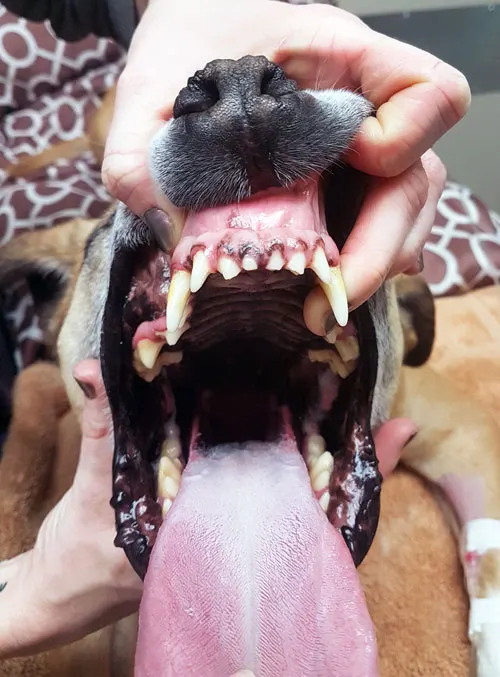
There are three concerns I hear most often when people talk about a dog’s professional dental cleaning:
- worry about the risks of anesthesia for dogs
- concern about how much a dog’s cleaning costs
- skepticism about the need to clean a dog’s teeth
Our vet allowed me to go “behind the scenes” for the cleaning, so I’m going to share some of my experience here today and try to address those concerns.
Anesthesia risks for dogs during a dental cleaning
One of the big obstacles for a lot of people who consider teeth cleaning is fear of putting their dogs under anesthesia.
Anesthesia is not without risks, particularly for older dogs. A study published in the Journal of the American Veterinary Medical Association found that overall health, age and weight along with the “urgency, complexity and anticipated duration of the procedure” all impacted a dog’s odds of dying while under anesthesia or sedation.
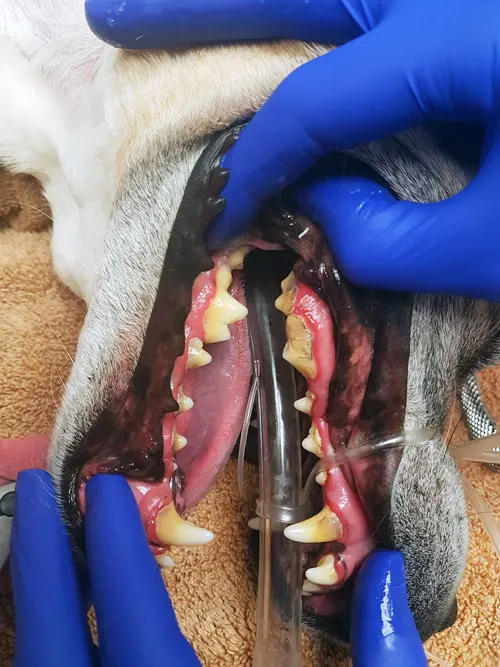
The study also highlighted the importance of pre-screening, precautions and monitoring during anesthetic procedures.
Going behind the scenes gave me a glimpse into the amount of preparation and attention that goes into putting a dog under anesthesia and made me much more comfortable about the anesthesia process.
The prep for my dog’s dental procedure was extensive and was all focused on his well-being.
Before the cleaning, we had to have a pre-appointment, where one of the clinic’s vet techs looked at Baxter’s teeth to try to assess how involved the cleaning would be (given that he was awake at this point, she did the best she could).
At this appointment, Bax also received a general physical check-up to make sure there were no issues that would affect him under anesthesia. They also looked at his bloodwork as that can be another way to identify any concerns.
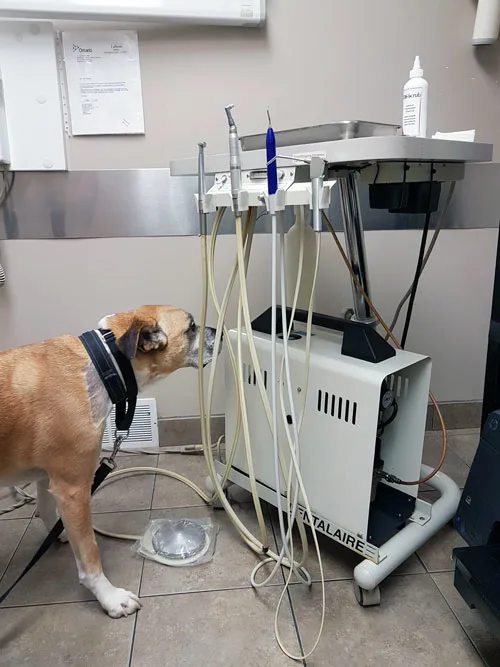
Minimizing risks for a dog’s dental cleaning under anesthesia
Baxter got the all-clear, so we booked our cleaning appointment for about a week later.
To prepare for the cleaning, Baxter was not allowed to eat for 12 hours before the procedure (although he could drink). Sometimes, anesthesia triggers vomiting in certain animals, and the vomit may get inhaled into their lungs or they may choke. An empty stomach lessens the chance of vomiting.
Upon arrival at the clinic, Baxter was weighed (so that the staff could ensure the amount of drugs he received was exactly correct) and the vet gave Baxter another exam (listening to his heart, taking his temperature, checking his colour) to make sure he was in good overall health.
With another all-clear, the vet tech began the first step of the cleaning: sedation.
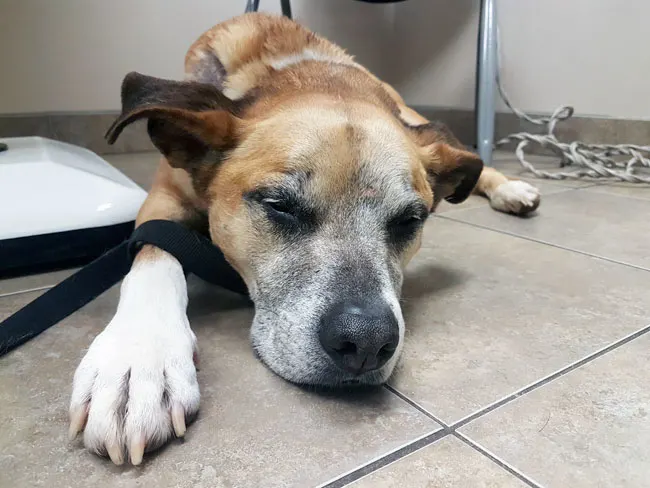
The sedative was given by injection and made Baxter vomit. This is intentional, again to lessen the chance of him vomiting during the procedure. Once Baxter was sufficiently drowsy, the vet tech along with one of the clinic’s assistants lifted him onto the table and started his IV.
The IV delivered a short acting anesthetic (propofol), which gave the staff time to put a tube down his throat. The tube delivered a constant flow of a gas anesthetic (isoflurane) during the procedure. The tube has a cuff on the end which is inflated to prevent vomit (if it happens) from going into the trachea.
A rolled up towel under Baxter’s neck also ensured that any water used during the cleaning ran out of his mouth and not down his throat.
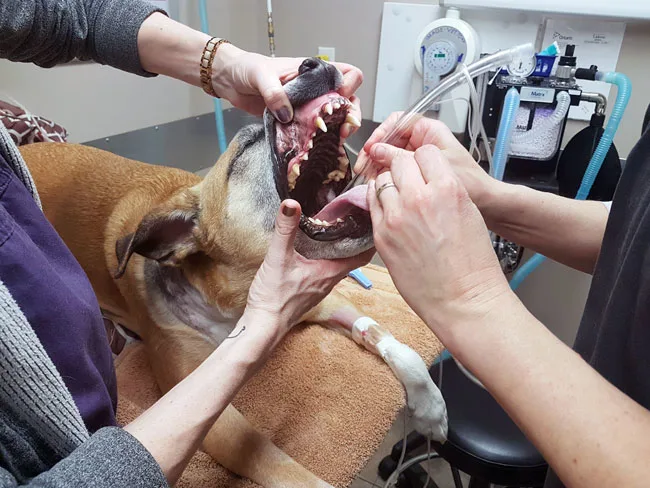
Some clinics may have tables which are specially designed for dental cleanings, which include drains or other features. Our clinic does not have one of these tables, so they use a lot of towels.
Baxter’s vital signs were monitored throughout the procedure to make sure he was doing alright. An SPO2 monitor on his tongue checked the oxygen in his bloodstream and his heartrate, and a cuff on his front leg tracked his blood pressure. (The shaved section on his neck is from his previous vet visit.)
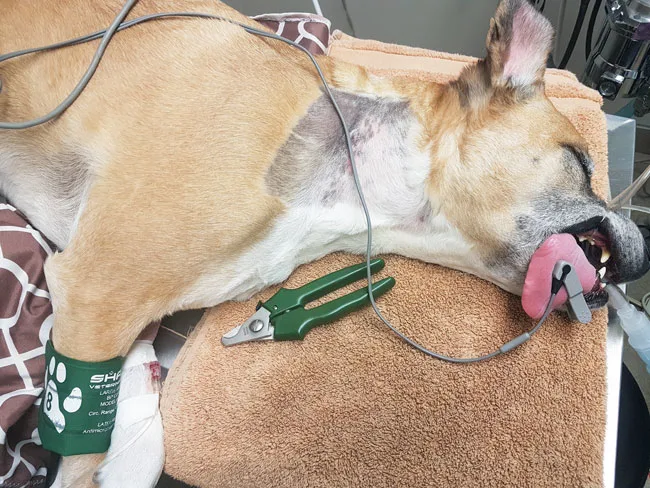
At one point, the clinic assistant was a bit concerned that Baxter’s blood pressure was too low. However, they had been watching his blood pressure all along, and it had been consistent throughout the procedure. It didn’t drop, so it seems like his normal pressure might be a bit low.
Throughout the cleaning, Baxter received fluids through his IV, which helped to maintain his blood pressure.
At another point in the cleaning, he seemed to regain consciousness a bit, so the vet tech increased the flow of anesthesia slightly to make sure he remained sedated.
When the vet tech was done cleaning his teeth, she switched off the anesthesia and let oxygen flow through the tube. The tube stayed in place while she lifted Baxter to the floor and began to wake him up with a massage and firm pats.
She also pulled his tongue to make sure he could swallow. Only then did she remove the tube from his throat.
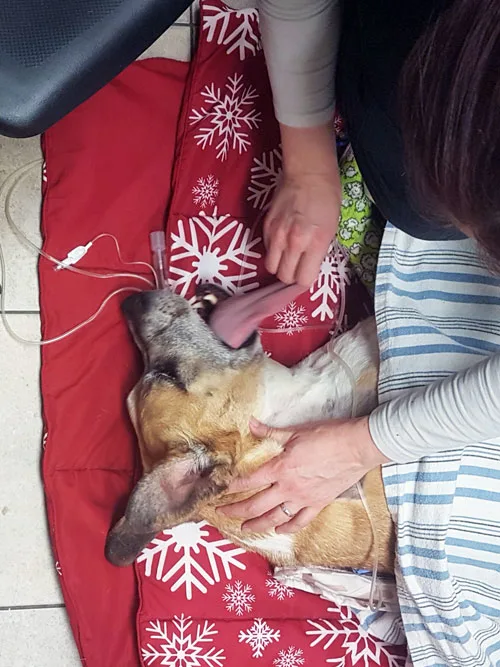
Baxter was awake but only barely. The staff moved him to a kennel where he could fully recover from the anesthetic. The tech stayed with him until he stood up, and they continued to watch him closely all afternoon.
By the time I picked him up four hours later, he was still a little groggy. Once home, he slept for four more hours before he seemed to finally be free of the anesthetic.
Clinic staff called the next day to check on how he was doing.
The amount of care that went into anesthetizing a dog was illuminating to me. Before, during and after, Baxter was carefully monitored. The staff took multiple steps to ensure he was safe and healthy at all points, and I appreciated their attention.
How much does it cost to have a dog’s teeth cleaned?
The cost of a professional dental cleaning for a dog or a cat is often a barrier. Some insurance programs do offer coverage for dental cleanings, but cleaning a dog’s teeth is not inexpensive. Baxter’s cleaning cost $592 (CAN). This included his pre-appointment, all drugs, bloodwork, paperwork, as well as staff time.
After going behind the scenes, I can see why the cost is what it is, and I feel it’s fair for the amount of work involved.
In terms of staff, it took three people to clean Baxter’s teeth. The vet tech did most of the work and led the procedure. She handled our pre-procedure check-up and did the actual cleaning.
The clinic assistant was also key, assisting with the anesthetic, monitoring Baxter, helping to lift and roll him as needed, and supporting the tech.
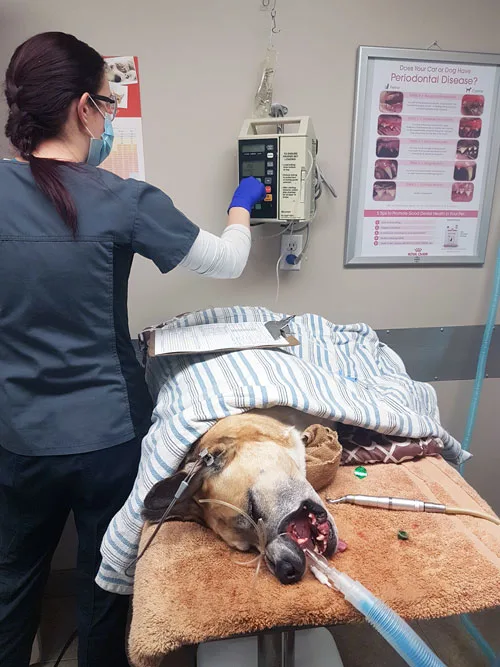
The vet joined the cleaning several times to assess any issues the vet tech identified and provide an overall check. Following the procedure, staff were with Baxter throughout much of the afternoon, continuing to check on him and make sure he was recovering smoothly.
Front desk staff also handled his weigh-in, appointment scheduling, check-in, checkout and billing.
From when we first walked into the exam room until when Baxter was moved to the kennel after the procedure, the time was 2½ hours.
While the cleaning perhaps ran a bit long due to my presence, this is an involved undertaking that requires an investment of time.
If cost is an issue for you, get a detailed estimate from your vet and have a discussion about what might be optional or what discounts they might offer. See our post: I can’t afford a dental cleaning for my dog.
There will be differences in how much clinics charge and how they structure their fees.
It can be worthwhile to shop around and see what cleanings cost at clinics in your area. Some also offer discounts or packages for “Pet Dental Month” in February.
At our clinic, they have set up pricing packages based on the size of the animal: less than 22 pounds, 22-55 pounds, and over 55 pounds. Larger animals mean bigger mouths, bigger teeth, more cleaning and therefore more cost.
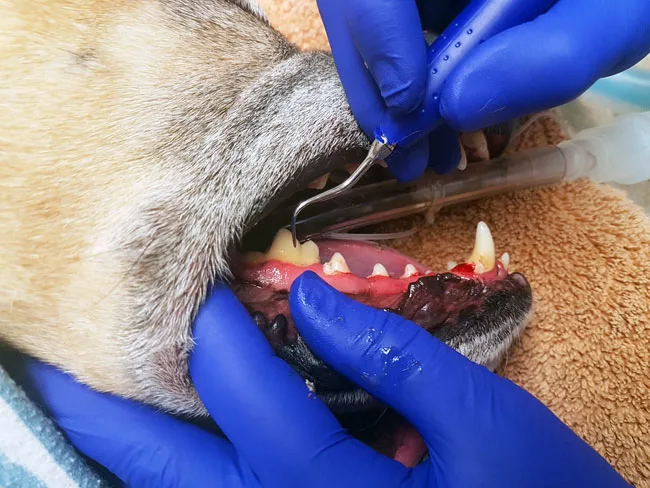
Cost of tooth extractions for dogs
Another factor that will increase the time, complexity and cost of a dental cleaning are extractions.
There are some options to repair dogs’ teeth, but usually if a tooth is damaged or infected it is removed.
Extractions can be a significant undertaking, depending on how large the tooth is and how it is rooted. The tech that handled Baxter’s cleaning was involved in one cleaning that required seven hours of extractions and another procedure where it took an hour to remove just one tooth.
Detaching the roots without breaking them and stitching the gums if necessary can be complicated. Technicians are not licensed to perform invasive procedures like removing teeth, so extractions are done by the vet.
At our clinic, general costs for extractions are $300 for a three-rooted tooth (molar), $200 for a two-rooted tooth and $100 for a single-rooted tooth. (The model below shows the size of the roots of some dog’s teeth.)
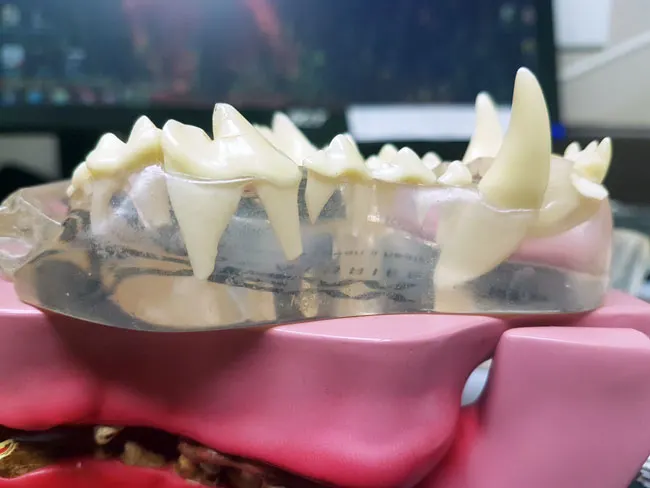
Our clinic has instituted a cap, so even if a dog has to have a lot of teeth removed, the cost will not go over $1,200—which is still very expensive and a good incentive to take care of our pet’s teeth.
Fortunately, Baxter did not require any extractions. See Lindsay’s post on her cat Beamer’s dental cleaning and extractions.
I appreciate how our clinic has packaged their fees and the cap for extractions. I feel like they are trying to be fair in their costs to ensure that animals get much-needed dental care. This is a very complex procedure involving multiple staff members and a significant amount of time, and the costs reflect that.
When should dogs have their teeth cleaned?
The other question that arises when talking about a professional dental cleaning for a dog is, “Does my dog really need his teeth cleaned?”
The answer is, “It depends.”
The state of your dog’s teeth depends on his diet, type of dog, age, how you care for his teeth at home and a number of other factors. For example, dogs on raw diets often have less tartar build-up than dogs who eat kibble.
Our clinic staff explained that they often see more tooth problems with smaller dogs and these breeds may require cleanings every two years. Larger dogs like Baxter may only need their teeth cleaned twice in their lives.
Regular brushing at home can diminish the need for a professional cleaning. As well, regular check-ups and exams with your vet can also assess the state of your dog’s mouth and identify if a professional cleaning is required.
At some point in a dog’s life, a professional cleaning will likely be needed.
This is because our dogs—like us—are constantly making tartar. Tartar starts as plaque, a film of bacteria in your mouth. If it’s not removed, plaque hardens and forms tartar, or calculus, and builds up on your teeth. Calculus can’t be removed by brushing—or any of the other techniques I tried at home.
Baxter had some tartar build up on his teeth, mostly along the gumline.
Dental cleaning to remove my dog’s tartar
The main focus of the cleaning was removing the tartar. The vet tech chipped it off using an extractor (a plier-like tool, which is also used for pulling teeth) and knocked it off using an ultrasonic scaler (which vibrates at a very high rate).
The chunks that came off were surprisingly large and thick. I felt comforted that it would have been very unlikely I would have been able to remove them myself at home.
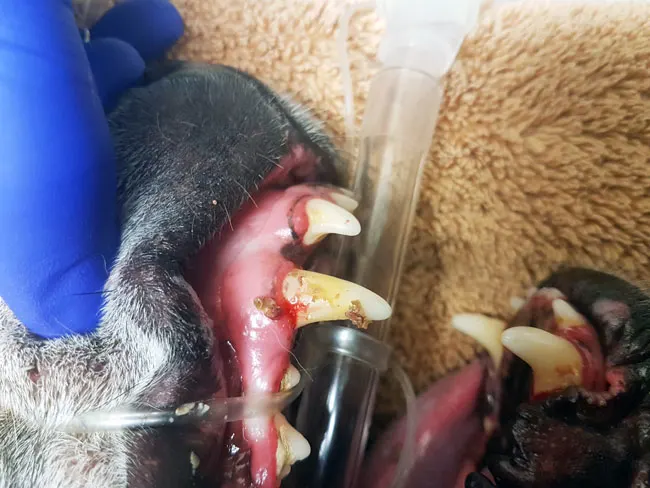
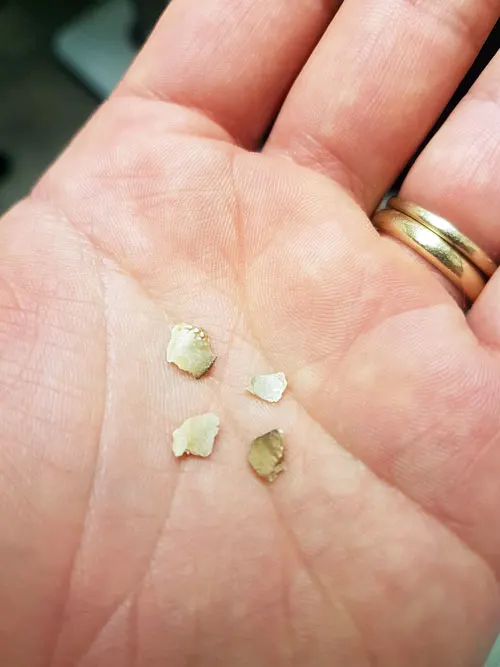
Checking my dog for damaged teeth
Once the tartar was removed, we were finally able to see the true state of Baxter’s teeth. I had been concerned that one of his back molars might have been damaged, but it was simply crusted with dirty calculus.
Cleaning revealed a small chip, but overall the tooth was absolutely fine. I was amazed at the transformation.
On the other side of his mouth, we did discover an issue that was more severe. The tip of one of his big upper molars (carnassials) had snapped off. The vet explained that since the back molars bear the brunt of force when Baxter is chewing, this injury is not uncommon. In Baxter’s case, the soft, interior “pulp” of the tooth was exposed.
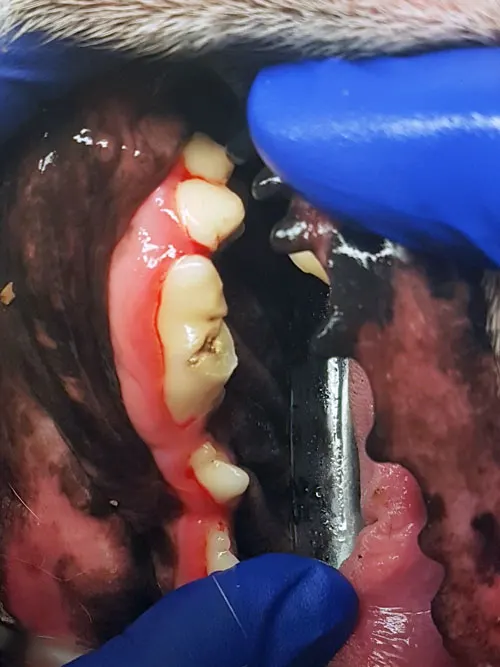
As I mentioned above, the usual fix when a tooth is damaged is to remove it. However, our vet explained that in this particular spot, the upper tooth is an important mate to the lower tooth, and removing one could lead to damage for the other.
Based on the vet’s recommendation and the fact that Bax doesn’t seem to be suffering any discomfort, I agreed to leave the tooth in place.
The usual process in a situation like this is for the vet to call the client and explain what they’ve discovered. Then the client makes the decision of whether to extract the tooth or not. If an extraction is performed, it is done right away, not in a separate surgery, so being reachable during your dog’s procedure is very important.
Our vet cautioned us that Bax is vulnerable to infection or sensitivity at this molar, and it may have to be removed in the future. However, he also said that the tooth may stay where it is for the rest of his life. For now, we’re simply monitoring Baxter and his tooth.
Healthy gums are also important for dogs
While the focus is on teeth and tartar, gums are an important part of a cleaning. Gingivitis occurs when your gums are inflamed due to plaque and bacteria on your teeth.
Tartar and gingivitis breaks down the bond between the tooth and gum, and our vet said that he is more concerned when he sees gingivitis than when he sees tartar.
The vet tech used a tiny probe to trace along Baxter’s gumline and identify any pockets or spots where his gums had receded, which would indicate disease. She also cleaned under his gumline.
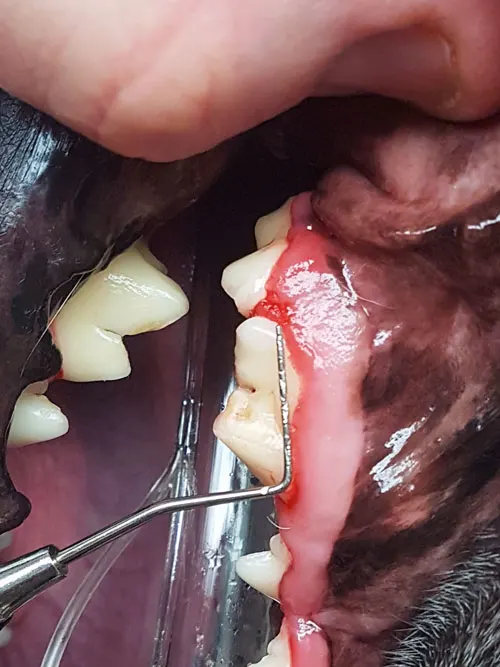
Baxter had a little bit of recession and one small epuli, a benign tumor that looks like extra growth of gum tissue. While epulis can grow and become serious issues, the vet did not feel it needs to be removed at this point.
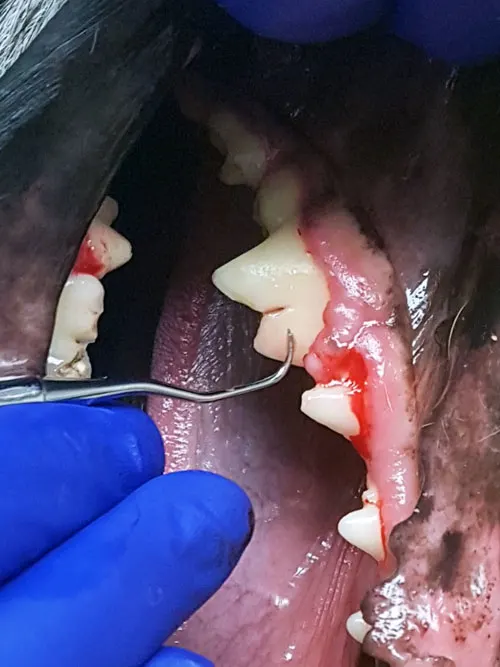
The tech finished the procedure by polishing Baxter’s teeth to remove any scratches and grooves. These grooves are created by scraping the tartar, and if they’re not polished away, they can attract more plaque.
Baxter’s dental cleaning was pretty straight forward. No major issues were uncovered (phew), and we know what to watch out for, from the epulis to the broken tooth. I also feel like we’re set up to take better care of Baxter’s teeth from now on. Starting with clean, tartar free teeth makes daily brushing a bit easier.
The best way to clean my dog’s teeth at home
Our vet’s biggest recommendation for cleaning Bax’s teeth is a large pressed rawhide bone (pressed rawhide, which is dense and hard, is more effective than dental treats that dogs devour in a few bites and safer than the rawhides with knots at the ends).
Chewing for an hour a couple of times a month will help to chip the tartar and calculus off the teeth. See Lindsay’s post, Are rawhides safe for dogs?
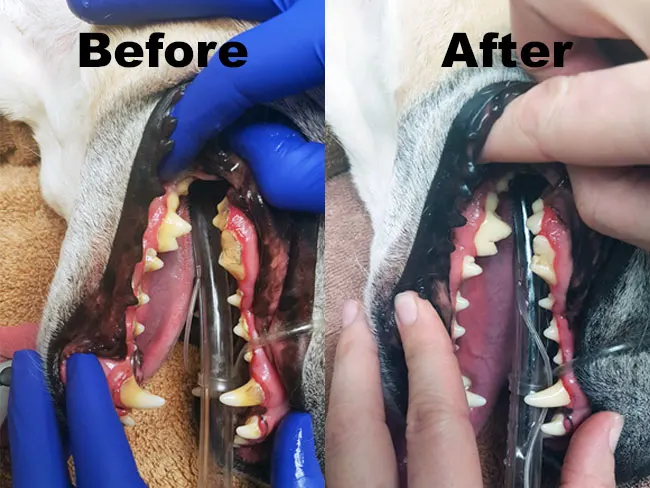
Is a dental cleaning for dogs worth it?
Going through this cleaning was worth it, in my opinion. Going behind the scenes on this procedure addressed any concerns I had about anesthesia, cost and need. And I hope that this article helps to answer some of your concerns too.
Oral health is important in our dog’s overall health. By taking care of Baxter’s teeth, we will help to keep him comfortable and healthy for as long as possible.
Has your dog ever had a professional teeth cleaning?
What was your experience?
Julia Preston is a blogger at Home on 129 Acres where she writes about her adventures of country living and DIY renovating. She and her family live on a 129-acre farm in Ontario, Canada.

Matnie
Sunday 16th of October 2022
Very informative, thanks! My large dog had her teeth cleaned at age 5 while also getting treated for oral cancer (some of her teeth had to be removed with the tumor) and I'm happy to say she's now cured. A few years later, we are going for her second cleaning and I'm a little nervous because she's been through so much but your insights were helpful. Thank you!
Heather
Thursday 9th of May 2019
Good to know that some dentists have maximum amounts. That’s excellent as it was exactly what I was worried about. In both Los Angeles and Houston I was able to find vets doing the equivalent of non-profit dentals from between $100-250 (plus bloodwork). I would have gone with a proper dentist but my dog had so many issues I was afraid it would be over $2k USD.
Julia T.
Thursday 9th of May 2019
I'm glad to hear that you found such a discounted rate and were able to take care of your dog's teeth. There are options out there. It may take a bit of sleuthing, but hopefully cost isn't a complete barrier for people to take care of their pets' teeth.
Michael Bell
Thursday 9th of May 2019
Julia, I have 3 dogs. Thank goodness 2 of them have very good teeth. One has so-so teeth. The vet said some dog breeds tend to have issues like that sometimes. He has had his teeth cleaned at least a couple of times, and never experienced any issues. Thank you so much for this article. I learned a lot about the process. Also, thanks for the tip about the possible Pet Health Month discounts. I will have to ask my vet about this.
Julia T.
Thursday 9th of May 2019
Glad you found the article interesting. Thank you for sharing your experience. It sounds like you're monitoring all of your dog's teeth well and doing your best to take care of them. I guess, two out of three's not bad? :)